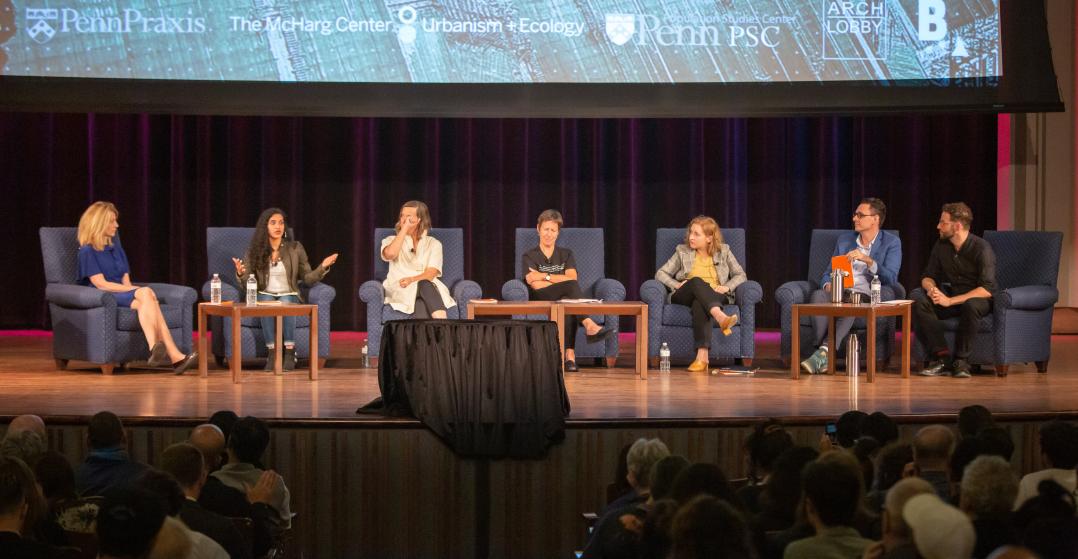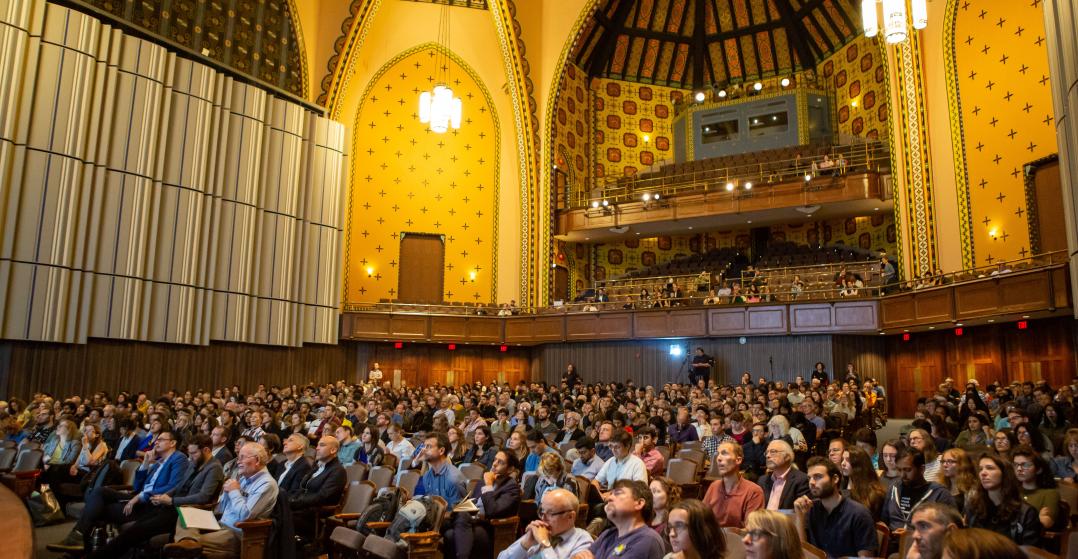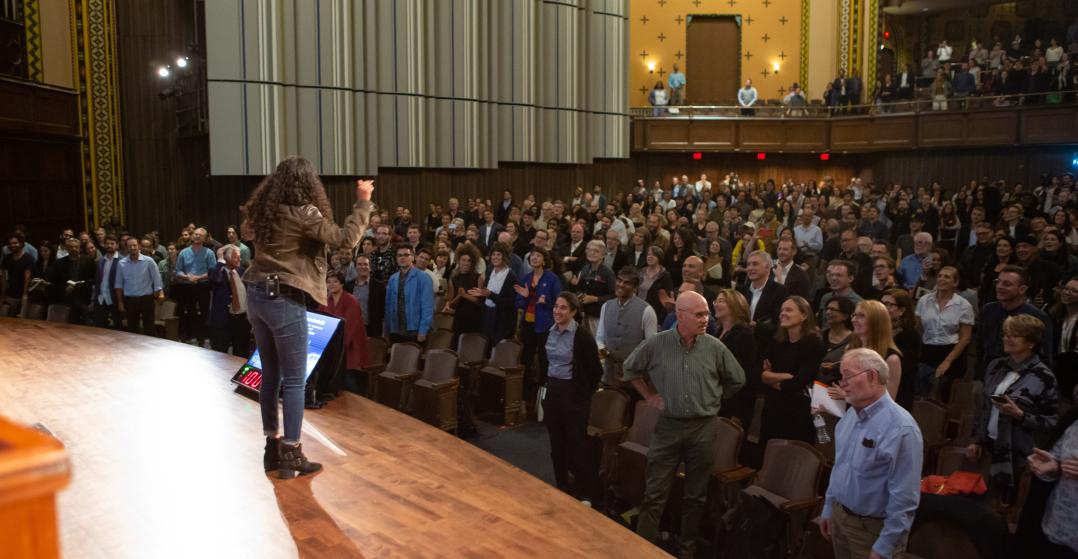
Crisis, Contestation, Coalition: A New Blog, A Green New Deal
Everywhere we turn, we’re told the end is near—the planet is on fire, and it will never be extinguished. The doomers, as they’ve come to be known—be they David Wallace-Wells, Jonathan Franzen, Paola Antonelli, or, at times, even the namesake of this Center, Ian McHarg—share a common sentiment: Humanity is doomed, and all that’s left to do is forestall or beautify the inevitable. Their dogma demands that we go slow, think small, and tweak systems instead of transforming them. Most of all, it demands that we lower our sights.
For Wallace-Wells, this conviction can be found in the opening sentence of the essay that launched his foray into the climate crisis: “It is, I promise, worse than you think.” It’s at the core of Jonathan Franzen’s latest ill-conceived essay for the New Yorker, in which he urged us to “accept that disaster is coming, and begin to rethink what it means to have hope.” It is what drives Paola Antonelli to ask us to accept that all we can do is design a “beautiful ending” for our species. And for McHarg, it emerged nearly fifty years ago, in his introductory jeremiad at the first Earth Day in Philadelphia: “Why do I have to be the one to bring you the bad news? You have no future. . . . the nation’s industries are the guarantee of your extinction.” In their writing, there is a pervasive sense that time is wearing thin and that the point of no return, if not already breached, is well within sight.
Beyond their sentiment, these doomers also share a comfortable distance—racially, materially, and generationally—from the frontlines of the climate crisis. We should not be surprised that older white Westerners in comfortable posts atop this nation’s elite cultural institutions find themselves incapable of seeing the roiling, nascent backlash to their solipsistic urges to abandon all hope. There’s nothing existential about the onset of global climate change for them. The planet may be on fire, but many of them will never know the extent of its heat.
Yet the planet is not the only thing on fire. Its people are too, ignited by the crisis climate change poses and by the promise of a Green New Deal. And because so many of us have so much to lose if we lower our sights and resign ourselves to designing a beautiful end, we aren’t afforded the luxury of proclaiming things are, indeed, worse than we think. We have no choice but to imagine that if we give everything we have, perhaps things could be much better than we think. We do not have to look far to understand why.
Earlier this fall, fifty thousand UAW workers struck for better pay, greater benefits, and the end of the two-tiered hiring system at General Motors; and in Chicago, thirty-five thousand Chicago Teachers Union members and over seven thousand SEIU school support staff struck in solidarity, winning raises and a commitment from the city to shrink class sizes, provide resources to homeless students, and place nurses and social workers in every school. We are only weeks removed from the Global Climate Strike—an action that brought more than eight million people to the streets, and which will continue each week, at smaller scales, as Fridays for Future sit-ins. Many of these climate strikers also joined the auto workers on the picket line. We are reaching the end of what can be accomplished by going slow, thinking small, and tweaking our power structures. The only card left to play is transformation.
It’s important to note here that nearly all of these climate actions are being organized and led by young people—many of them young Indigenous people and people of color. There is a simmering (perhaps now boiling over) sense among Millennials and Gen Z that their future has been stolen; that this generational theft has left them downwardly mobile; and that those responsible will be long dead by the time the worst of the climate crisis sets in. This sense is pervasive among young designers and others in the Professional-Managerial Class, who see the prospects for conventional success—becoming a principal or owning a firm, securing tenure in the academy—not only dimming, but becoming less clearly desirable at all. Whether in private practice or the university system, we’ve yet to resolve our relationship to—and complicity in—the systems of power that have structured inequality, dispossession, and ecological collapse across the Earth. As I asked in Places Journal earlier this year, can a set of practices tied to luxury real estate and urban development deliver anything meaningful to communities impacted by climate change and inequality? Can design be an activist force in the fight for climate justice while it remains an instrument of neoliberalism? If we were to probe those questions seriously, I don’t think we’d like the answers.
And yet, our conventional platforms for Very Serious publishing remain stubbornly disconnected from the overlapping crises that now shape every rising generation of designers. They too are slow, small, and focused on tweaking our bodies of knowledge. At their best, our peer-reviewed journals force scholars to slog through years of reviews, revisions, and resubmissions, much of which is dictated by the idiosyncrasies and grievances of the reviewers—some of whom are stunned to learn that not everyone has found their work relevant to every article they dare to send into the peer-review ether. At their worst, they are a system of paywalled, lightly read journals governed by a small cabal of gatekeepers who, to the extent that they are at all invested in cultivating a rising generation of scholars, tend to elevate intellectual clones rather than dissidents—people who will parrot their work rather than challenge it.
Outside of this peer-reviewed system, the publishing landscape for designers is vanishingly small. Though there are a few exceptional outlets that often commission design writing, they can be difficult for new authors to crack—and there are few, if any, platforms dedicated to cultivating young designers’ writing and to creating pathways to publishing beyond the conventional structure. We need more on-ramps to these kinds of cultural platforms.
***
There, in the sparsely populated space between those exceptional outlets and where most design scholars begin, is where the McBlog sits. An online platform at a small, scrappy research center cannot solve all of these problems. But we can give whatever platform we’ve built to the rising generation of designers who will lead—and are already leading—the response to our overlapping crises of climate, capitalism, and resurgent fascism.
To that end, we’re launching Ian McBlog with a series of essays developed by a group of rising designers from the University of Pennsylvania. Their work began as a part of the “Design With Nature Now” conference in June 2019, and their posts will serve as a way to extend their ideas to broader audience than that convening allowed. Some might say “what a shock—the University of Pennsylvania, itself an elite institution, is elevating its own people.” And I would largely agree—I grew up poor, in rural Arkansas, and find so much about Ivy League culture to be alienating and counterproductive. But things like this must begin somewhere, and I can think of no better place than with these seven brilliant young designers who brought down the house at “Design With Nature Now.”
As the first entry in this new blog, readers should consider this a call for pitches. We want young designers to see this platform as a way to develop their voice, to build up their ideas, and to cultivate a community of colleagues and comrades. We have no preconceptions or prejudices regarding content. But we do feel strongly that designers and writers—especially students and young professionals—deserve to be paid for their labor, and so every successful post will receive $200 in remuneration.
Nothing is settled. Nothing is certain. All that’s left is to fight for an alternative future.


